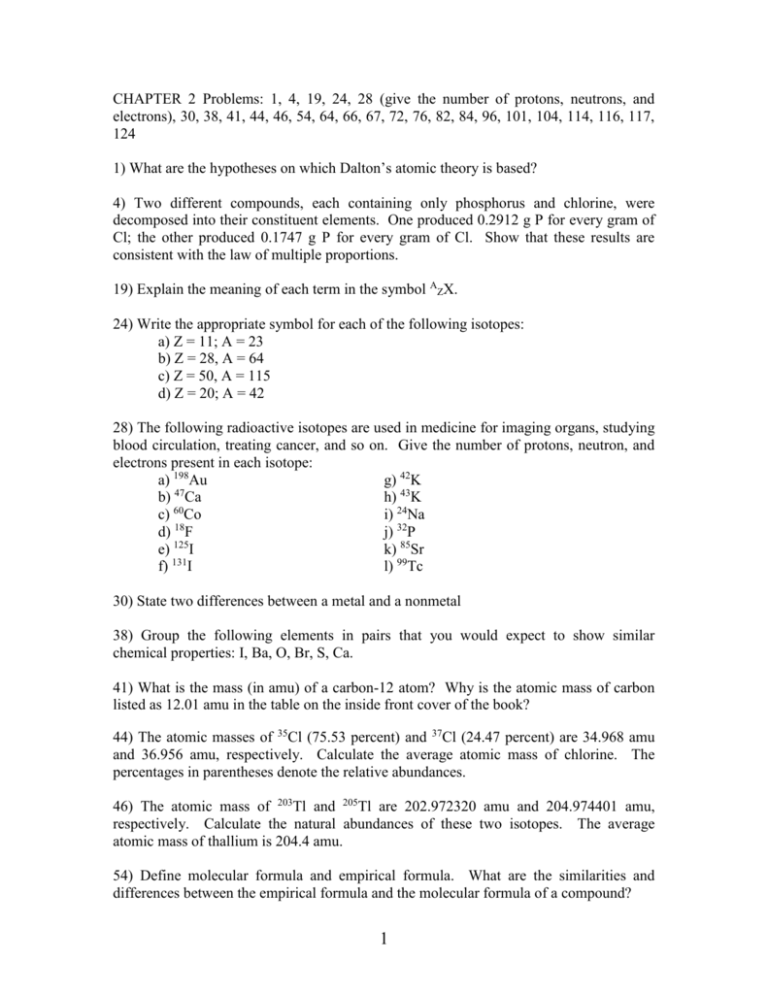Chapter 1 - Solutions
advertisement

CHAPTER 2 Problems: 1, 4, 19, 24, 28 (give the number of protons, neutrons, and electrons), 30, 38, 41, 44, 46, 54, 64, 66, 67, 72, 76, 82, 84, 96, 101, 104, 114, 116, 117, 124 1) What are the hypotheses on which Dalton’s atomic theory is based? 4) Two different compounds, each containing only phosphorus and chlorine, were decomposed into their constituent elements. One produced 0.2912 g P for every gram of Cl; the other produced 0.1747 g P for every gram of Cl. Show that these results are consistent with the law of multiple proportions. 19) Explain the meaning of each term in the symbol AZX. 24) Write the appropriate symbol for each of the following isotopes: a) Z = 11; A = 23 b) Z = 28, A = 64 c) Z = 50, A = 115 d) Z = 20; A = 42 28) The following radioactive isotopes are used in medicine for imaging organs, studying blood circulation, treating cancer, and so on. Give the number of protons, neutron, and electrons present in each isotope: a) 198Au g) 42K 47 b) Ca h) 43K c) 60Co i) 24Na 18 d) F j) 32P e) 125I k) 85Sr 131 f) I l) 99Tc 30) State two differences between a metal and a nonmetal 38) Group the following elements in pairs that you would expect to show similar chemical properties: I, Ba, O, Br, S, Ca. 41) What is the mass (in amu) of a carbon-12 atom? Why is the atomic mass of carbon listed as 12.01 amu in the table on the inside front cover of the book? 44) The atomic masses of 35Cl (75.53 percent) and 37Cl (24.47 percent) are 34.968 amu and 36.956 amu, respectively. Calculate the average atomic mass of chlorine. The percentages in parentheses denote the relative abundances. 46) The atomic mass of 203Tl and 205Tl are 202.972320 amu and 204.974401 amu, respectively. Calculate the natural abundances of these two isotopes. The average atomic mass of thallium is 204.4 amu. 54) Define molecular formula and empirical formula. What are the similarities and differences between the empirical formula and the molecular formula of a compound? 1 64) Write the empirical formulas of the following compounds: a) Al2Br6 d) K2Cr2O7 b) Na2S2O4 e) H2C2O4 c) N2O5 66) Write the molecular formula of ethanol. The color codes are black (carbon), red (oxygen), and white (hydrogen). 67) Name the following binary molecular compounds: a) NCl3 c) P4O6 b) IF7 d) S2Cl2 72) What is an ionic compound? How is electrical neutrality maintained in an ionic compound? 76) Give the number of protons and electrons in each of the following common ions: a) K+ e) Mn2+ b) Mg2+ f) C43+ c) Fe g) Cu2+ d) Br82) Name the following compounds: a) KClO b) Ag2CO3 c) HNO2 d) KMnO4 e) CsClO3 f) KNH4SO2 g) FeO h) Fe2O3 i) TiCl4 j) NaH k) Li3N l) Na2O m) Na2O2 2 84) Write formulas for the following compounds: a) copper (I) cyanide b) strontium chlorite c) perbromic acid d) hydroiodic acid e) disodium ammonium phosphate f) potassium dihydrogen phosphate g) iodine heptafluoride h) tetraphosphorus decasulfide i) mercury (II) oxide j) mercury (I) iodide k) selenium hexafluoride 96) What is wrong with the name for each of the following compounds: a) BaCl2 (barium dichloride) b) Fe2O3 (iron (II) oxide) c) CsNO2 (cesium nitrate) d) Mg(HCO3)2 (magnesium bicarbonate) 101) Write the formula for the common ion derived from each of the following: a) Li e) Al b) S f) Cs c) I g) Mg d) N 104) Determine the molecular and empirical formulas of the compounds shown here. (black = carbon, white = hydrogen). 114) Predict the formula and name of the binary compound formed from the following elements: a) Na and H d) Al and F b) B and O e) F and O c) Na and S f) Sr and Cl 3 116) Show the location of the a) alkali metals; b) alkaline earth metals; c) halogens; d) nobel gases in the given outline of the periodic table. Also draw dividing lines between metals and metalloids and between metalloids and nonmetals. 117) Fill in the blanks in the table. Cation Anion Formula Name Magnesium bicarbonate SrCl2 3+ Fe NO3 - Manganese (II) chlorate SnBr4 Co2+ Hg22+ PO43ICu2CO3 Lithium nitride Al 3+ S 2- 124) A cube made of platinum (Pt) has an edge length of 1.000 cm. The density of Pt is 21.45 g/cm3, and the average mass of a single Pt atom is 3.240 x 10-22 g. a) Calculate the number of Pt atoms in the cube b) Atoms are spherical in shape. Therefore, the Pt atoms in the cube cannot fill all of the available space. If only 74 percent of the space inside of the cube is taken up by Pt atoms, calculate the radius (in pm = picometers) of a Pt atom. Recall that for a sphere with radius r is V = 4/3 r3. 4











